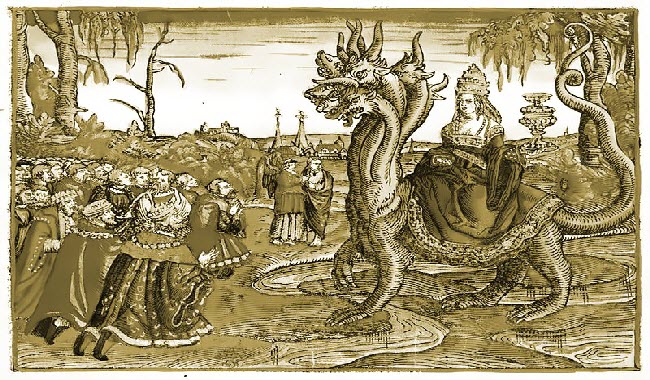The book of Revelation tells of “Mystery Babylon” that will rule at the end time. Many were convinced once that it must have been Saddam Hussein, since Iraq formerly was Babylon, but who is it, really?
Since it is called mother of harlots and abominations of the earth, why not look at it from a Biblical perspective?
We know from the prophecy of Daniel 2 that Babylon would be the first of a succession of empires that would use cheaper forms of currency, right up until the final empire, which would be a confederacy composed partly of iron and of clay. If you read my earlier essay on Daniel 2, you know what I’m writing about.
Some have argued that it is the Catholic Church who is the “false prophet” of the “beast/prophet” duo of Revelation, but really, who is the “mother” of all these religions that have spawned from its single source? Who could be a “harlot” from a Biblical perspective?
How about the nation of Israel? Deuteronomy 4:35 points out that God dealt only with Israel, and Amos 3:2 says that Israel was the only one of all the families of the earth with whom God dwelt. Jeremiah 3;14 says God was married to Israel, and they were unfaithful to him, so who really has a direct biblically proven connection to God? Well, Israel.
But why connect Israel to Babylon? Historian Max DiMont tells us that when Cyrus of Persia allowed Israel to return to Palestine, the majority of Jews chose to stay in Babylon and sponsored the return of other Jews who wished to return to their homeland. Why? As DiMont writes, the Jews of Babylon had become quite successful by living along the trade routes of Babylon, and were satisfied with their wealth.
What many do not know, however, is that the Talmud, which is the oral law of the Jews, as a written commentary on the Torah, is recognized as having its origin in Babylon. The Talmud was a “final’ oral commentary that followed the Mishna, Gemara, resulting finally in the Talmud. This evolution from Mishna to Talmud is aptly described by Louis Ginzberg as quoted in DiMont’s book “The Indestructible Jews”:
“The development of commerce and trade under the Hasmonean rulers peremptorily called for the building up of a code of civil law. The few rules found in scripture bearing on this branch of the law were not sufficient and could not be made so, not even by the most subtle reasoning of the cleverest interpretation. The time was certainly ripe for legislation. Every student of the history of jurisprudence knows that great as are the possibilities of interpretation, an old code has limits beyond which it cannot be stretched. When the breaking point is reached, legislation comes to the rescue (sound familiar?)… But how dare one tamper with sacred scripture, in which the Divine Will is revealed? The sages and scholars [formed] a new code–they created the Mishna”
Mishna developed as a result of legislation needed for trade and commerce. Later the Gemara was added, according to DiMont as commentary on the text of Mishna. But it was the Talmud which finally became the commentary recognised by Jews as the official commentary on Torah, and it derived its authority from Babylonian origins. By the tenth century, writes DiMont, the Talmud had become the “common law” of the diaspora. Notice that the law was not Torah itself, but the Talmud, which had evolved as a result of the human commentaries on the Torah.
It is interesting also to note from the Free Mason book titled “Morals And Dogma”, that:
“The dominant system among the Jews after their captivity was that of the Pharoschim or Pharisee. Whether their name was derived from that of Parsees, or followers of Zoroaster, or from some other source, it is certain they had borrowed much of their doctrine from the Persians. Like them they claimed to have the exclusive and mysterious knowledge, unknown to the mass…They styled themselves Interpreters; a name indicating their claim to the exclusive possession of the true meaning of the Holy Writings, by virtue of the oral traditions which Moses had received at MT Sinai.”
You will remember from Matthew 23:1 that Jesus admitted the scribes and Pharisees sat in “Moses’ seat”. It was also in that chapter that Jesus condemned them as hypocrites. he further warned his disciples against the “leaven of the Pharisees”, who taught “for commandments the traditions of men”. What an excellent description of Talmud!
It was the Pharisees who finally eliminated all competitive religious views from Judaism and became the dominant system of thought. It was also the Pharisees who developed the rabbinical priesthood who were seen as the true spokesmen of God’s word and the Talmud. They and the scribes of Jesus’ day were the lawyers and legal experts.
This evolution of Talmudic law, writes DiMont, introduced new methods of doing business based on credit and negotiable securities instead of gold on the barrel head. Whereas Roman law had held that indebtedness was personal and that creditors could not sell a note of indebtedness to someone else, Talmudic law recognized impersonal credit arrangements. Talmudic law held that a debt had to be paid to whoever had honestly acquired a debtor’s note…There is clear evidence that these new easy credit arrangements, and the Talmudic laws enforcing the honoring of notes and debentures, led to the coming of international capitalism.”
DiMont further points out that concepts of common law and due process were shaped in the tenth century by Maimonides, and that trade and civil law was introduced to the Anglo Saxons by Jews whom William the Conqueror has brought along for that very purpose.
Jesus himself had specifically warned against the Pharisees, and it was the Pharisees who had gradually developed an international system that would begin to facilitate growth by the development of credit schemes that evolved into modern day banking.
And returning to the final empire described in Daniel chapter 2, we see the iron mixed with clay. And what is the clay? Perhaps Habakkuk 2:6 might give a clue:
“Shall not all these take up a parable against him, and a taunting proverb against him, and say, woe to him that increaseth that which is not his! How long? And to him that ladeth himself with thick clay”.
This reference to “clay” according to the Hebrew, refers to pledges, notes of debt, credit. It was the Pharisees of whom Jesus warned us. It was the Pharisees who developed traditions of men that substituted for commandments of God.
But during Jesus’ life, the Talmud and its laws had to be somehow reconciled to give it a force of truth. The rabbi Hillel, who was a contemporary of Jesus, developed what became known as the “Seven Laws” of thought that would properly interpret human concepts of the Talmud. From this disciplined concept of laws, the Pharisees would derive their proper understanding of the Torah.
The rabbis, trained in these concepts, would become the interpreters who would sit in “Moses’ seat”.
But we see Jesus telling us to call no man master, or rabbi, or father. We see Jesus condemning the practices of the Pharisees and warning against the “leavening” of the Pharisees. Even further, as Hillel had claimed a logical process that properly defined human understanding of God’s law, Paul had written that the natural mind was enmity against God’s law and could not be subject to it(Romans 8:7).
It was at this point that a great revolution occurred. Was a person right in refusing to acknowledge the authority of other men? Jesus said to call no man master or rabbi. The rabbis themselves claimed the right to properly interpret the laws of God according to logic and reason.
The Pharisees themselves have evolved through the ages, as shown by historians. Modern banking has evolved to challenge the practice of loaning at interest, “usury”, in direct violation of God’s statements of Exodus 22:25. Leviticus 25:36-37, Deuteronomy 23:19-20, Nehemiah 5:7, Isaiah 24:2, and on the list goes.
Today, we are looking at a system of trade that developed from Babylon and came to be a part of the whole world system of commerce, a system that “fornicated with the kings of the earth”. It is a system of false prophets who will deceive the whole world, and how best to deceive someone? By operating from within the most sacred and cherished institutions, actually appearing to the source of goodness, when all along it is the very opposite.
Who is “Babylon the Great”? Where does the evidence point?


That Babylon writer is smart!